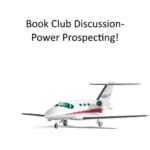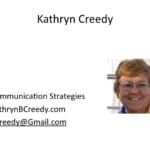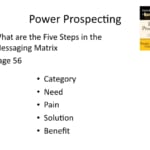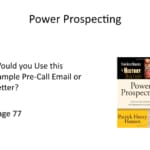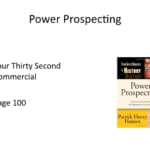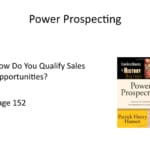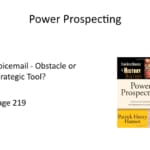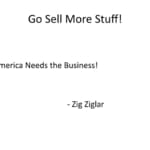Power Prospecting- Cold Calling Strategies for Modern Day Salespeople
Kathryn Creedy of Communication Strategies, Lillian Tamm of Avicor Aviation, John Williams and Paula Williams of ABCI discuss Patrick Henry Hansen’s book, Power Prospecting, from the point of view of aviation sales and marketing professionals. What was useful? What was not quite so relevant?
Paula Williams: So, Welcome to our book club discussion. This week we’re talking about Power Prospecting, by Patrick Henry Hansen. Which is kind of a different book than what we usually go in for. But it was highly recommended to us. He’s a local guy, here in Salt Lake, and we thought we’d give it a shot.
I’m Paula Williams, with ABCI. I’m the facilitator and I run the aviation marketing company, [LAUGH] with John. And John, you are?
John Williams: Hi, I’m John Williams and I work for her.
Paula Williams: [LAUGH]
 John Williams: Well, I do, don’t laugh. It’s her company, and I help with all the back-end stuff. She’s the out-front person.
John Williams: Well, I do, don’t laugh. It’s her company, and I help with all the back-end stuff. She’s the out-front person.
Paula Williams: Fantastic, and Kathryn?
Kathryn Creedy: Hello, I’m Kathryn Creedy, I’m communication strategies, copyrighting, public relations strategizing, and social media.
Paula Williams: Fantastic, and Lillian?
John Williams: I’m Lillian Tamm. I’m with Avicor Aviation.
We do evaluations of aviation businesses and different kinds of consulting to the aviation industry. Industry research and things like.
Paula Williams: Fantastic. I think this is the first book club we’ve ever done. Our first podcast, or webinar, we have ever done where we had a majority of women. So we’re breaking new ground today.
John Williams: I could leave.
Paula Williams: Not at all, it’s just fine. You can be here. We like having you, John.
First of all, I just wanted to kind of get your thoughts on what you thought of the book, in general, before we jump into it. What did you think John?
John Williams: I think the thing that hit me most was his thoughts on courage.
Paula Williams: Yeah?
John Williams: Not the absence of fear.
It’s the mastery of fear. Because it’s everywhere, and cold-calling just exemplifies it. That’s why, he says and I agree, that most people don’t do that.
Paula Williams: Because they don’t have the courage, right?
John Williams: Yeah, they’re afraid.
Paula Williams: Yeah, absolutely. What did you think?
Kathryn Creedy: I thought, on the cold-calling, having a strategy around the cold-calling.
That’s something I’ve done for awhile. Name, phone number, state your business, tell him what you going to do. I.e., call me back, or I’ll follow up with an email, or follow up with a phone call at such-in-such a time. If that’s not convenient, you set the time. I thought that was a really, really, really, good strategy.
Paula Williams: Fantastic, great.
Kathryn Creedy: [CROSSTALK] you’re organized.
Paula Williams: Yeah, and that’s so impressive. I mean, everybody that we get cold-calls from is not organized. So I think that makes a big difference. Lillian, how about you?
Lillian Tamm: It was kind of interesting for me. Because, in doing the type of consulting that we’ve done, we’ve never cold-called.
We’ve done the odd thing, but it’s never been a big portion of it. Because we do evaluations, it tends to be something that people call us for. Because they don’t even think of it. It’s not something that people tend to do unless they’ve got a reason for it.
And that reason isn’t something that they think about way ahead of time, typically.
Lillian Tamm: A lot of the principle I sort of knew, but it was interesting to read a whole book about it.
Paula Williams: Manual versus electronic CRM. I have an opinion on this, but I’ve shared way plenty so I’ll keep my mouth shut.
John?
John Williams: [LAUGH] Well, having used both, I can tell you electronic CRM is one great, big advantage to anything you do, with having to do with sales. Particularly today. It wouldn’t have done you much good 30 years ago, but today-
Paula Williams: Right?
Kathryn Creedy: I don’t really having opinion on it, so I’ll pass.
Paula Williams: Okay, that’s fair.
Lillian Tamm: I think electronic makes most sense, no question. Not that I’ve actually implemented it, but I do think that-
Paula Williams: There is a difference. If you’re a broker or somebody like that. And you have got only ten prospects that you need to keep track of at any given time.
I suppose, you probably could do that with a spreadsheet just as easily. But most of us want to keep track of people over five, ten, 15 years. And the only way to do that, in my opinion, is electronically. Nobody has that kind of time to do that any other way.
So I did end up sharing my opinion, so there you go. The next big thing was, what goes into an ideal customer profile? I thought this was really helpful. I actually did one for us. John, what do you think? These are the ones that were in the example in the book, of course.
Why is this important?
John Williams: Then there’d have to be demographic information on your particular customer you’re looking for.
Paula Williams: Right.
Kathryn Creedy: More importantly, I think it helps you organize your thoughts about what you can do for them to help grow their business. Basically, again, this goes back to organization.
Who are these people and why do you want to do business with them? And why should they want to do business with you? All of those organizing all those thoughts I think is very important going in. And scripting it is equally important, as Patrick Hanson said.
Paula Williams: And Kathryn, when you and I start working with a client, Kathryn writes for us, for a lot of our clients.
And she really needs to know, or you really need to know the ideal customer profile, because you need to know who you are trying to attract with your writing.
Kathryn Creedy: Absolutely, target audience, I do these little exercises a lot. What is your target audience, who do you want to reach?
And I find that a lot of people don’t have that organized in their head. They kind of say, well, I want to reach flight schools or I want to reach students. But they don’t say what specifically what organizations they want to reach.
Paula Williams: Mm-hm.
John Williams: Or they may even want to say, I want this particular section of the country.
Kathryn Creedy: Yeah.
John Williams: And that’s cool, but that needs to be narrowed down.
Kathryn Creedy: Yeah, yeah. And if they can’t define it, then they aren’t very organized. And you need to help them, or we need to help them organize those thoughts. Ask the right questions so that they can get to their ideal customer, their target audience or whatever.
Paula Williams: And the more specific this is, the more effective it is in terms of writing or any other kind of marketing. Lillian, how about you? How has this worked for you, or have you thought about it in your business?
Lillian Tamm: We have done that to a degree. Because there are some companies that just aren’t ready or suitable for some of the things that we do.
But reading this helped to focus it a bit to the next level, if you will. And I think that, I mean it’s one of those type of things. I mean, my background was in business administration, economics, that kind of stuff, when I went to school. And I remember a lot of the marketing classes talking about you’ve always got to think about your customer.
Now, I know that was a long time ago that I took those classes, but that’s kinda stuck with me. And even in doing things like when you do your website or marketing materials, you gotta look at what the guy who’s at the other end is looking for. And even in choosing who your prospects are, are they going to have a need for you and are they the ideal one?
Are you wasting your time, spending too much time on somebody that isn’t really going to respond? So a lot of the information in the book, and this part I think really sort of helped to gel that.
Paula Williams: Yeah.
Kathryn Creedy: How do you say it, Paula? Random acts of marketing are useless.
Paula Williams: Yeah, definitely. And even though we preach this all the time, I don’t always do it as specifically as we should for our company even. So this book was really good for me to go through and do some of the exercises and go, wow, I thought I had this.
But I really didn’t have it as specifically as I should have. And it really makes it easier to write copy, and to develop materials, and to figure out what lists we want, where we should spend money, where we shouldn’t spend money. Which is really helpful.
Paula Williams: All right-
Kathryn Creedy: That’s, that’s sort of-
Paula Williams: Yeah, go ahead.
Kathryn Creedy: I was going to say that’s sort of what I found too. That it helped me focus on some of the more minutiae that I should be focusing on, specifically with my customer profiles and targeting.
Paula Williams: Right.
Kathryn Creedy: Real good.
Paula Williams: And minutiae, that’s John’s favorite word since we saw The Guardians of the Galaxy, right?
Kathryn Creedy: [LAUGH] There you go.
Paula Williams: We didn’t have time to work on the minutiae of the plan. [LAUGH]
Paula Williams: All right, so what are the five steps in the Massaging Matrix? And again, this is one of the most things.
I actually made a table like they did in the book for my customers of category, need, pain, solution and benefit. And it was pretty enlightening, and in some ways you have to have more than one. And I figured out, you know what? We need ten different tables for ten different customer types, depending on what they need.
What do you think, John?
John Williams: Well, I don’t know how to say this. You have a high, medium, and low level. And this is probably hitting about the average for the right start, which is a good for most people.
Paula Williams: Okay.
John Williams: But I think it needs to be more specific on any given business.
Paula Williams: Fair enough.
Kathryn Creedy: Well, again, it goes back to figuring out what you can do for them and why they want to work with you. So, yeah, you’re going to have to have numerous messages depending on the client.
It’s like a resume and a cover letter. You want to make sure that it addresses everything in that job posting. It’s just tailoring your audience.
Paula Williams: Great. Lillian, how about you?
Lillian Tamm: Yeah, I haven’t had a chance to go through and work through this for our company yet.
But it’s on my list for this week actually.
Paula Williams: Okay.
Lillian Tamm: Cuz I think it’s a really good strategy for focusing. There’s a lot of different niches that we target, and I think it’s going to be like you said. There’s maybe, you’ve got ten different situations that you need to do.
I probably have that too. And I think that’s a very useful tool, to be able to focus on specific niches that you address.
John Williams: What’s interesting with your company is I think that every company has a need for what you do. But there are very few that understand enough that they need it, to have-
Lillian Tamm: That is actually true. A lot of companies could use evaluation just to determine where they are now and see where they’re going. And that’s something that I think all of us could. You have to sometimes take a look back at your own finances or whatever. So your company is the same way.
You’ve gotta take a look and step back and see, where am I? [CROSSTALK] Yeah.
John Williams: When I went to business school they spent an inordinate amount on time on evaluation, and the need, and so forth. It was quite interesting.
Paula Williams: One thing that we found with companies when we start we working with them.
A lot of times their sales presentations are just feature, feature, feature feature, feature, feature, feature, feature, feature, without considering, who is this customer? What needs do they have? What pains are these features supposed to be addressing? But you really shouldn’t even bring up a feature unless It applies very specifically to that customer.
And this discipline really forces you into that mode of thinking about the customer, more specifically than I think anybody in the aviation industry does.
Lillian Tamm: That’s probably true for the most part.
Paula Williams: Yeah, yeah, cool, all right. Okay, and then I didn’t make a copy of this in the slideshow.
But there is a pre-call email or letter, just a real simple thing, in the book that I think is an interesting idea. I had not done this before. Often, we’ll send a package prior to a sales call or most of the calls that we do, like you, Lillian, are not cold calls but they’re inbound marketing.
People have contacted us for some reason and then we contact them after the fact, but,
Paula Williams: Do you have any thoughts on this specific email or letter? Is this something you would use? Is this something you’d adopt or do something different or what are your thoughts, John?
John Williams: Well, I don’t know, this is a pre-cold call email, right?
Paula Williams: Yeah.
Lillian Tamm: Yeah.
John Williams: Yeah, yeah, yeah. I would absolutely use an email. The problem is, I mean, I have sold used cars for a while and I mean, everybody that walked in the lot, it’s like a cold call. But their intent is if you can’t sell them, you pass them off to somebody else, but it’s the same thing.
You don’t have any precursor, you don’t even know the person’s name. Whereas if you can at least do an email, and maybe get a response. Even if you don’t get a response, you can say, well, I sent you this email. And didn’t know if you had time to read it or whatever and you can go down that road, then it makes it not a completely cold call.
Paula Williams: All right,
Paula Williams: Kathryn, what’s your thinking?
John Williams: I don’t know about-
Paula Williams: Go ahead.
John Williams: I don’t know about a letter.
Kathryn Creedy: I would not do a letter because I think that’s, unless you’re going to do something the way you do it, Paula, which is send a letter with a little gift or something that will attract their attention.
But that’s further down the line, I think, that’s effective more further down the line. But I think everybody is focused on email these days. You just have to get a catchy title to the email and hope that it’s enough to bring somebody to open up the email.
Paula Williams: Right, that’s where good writing comes in.
If you don’t have a fantastic headline, and most people don’t spend enough time on headlines.
John Williams: As a matter of fact, rather than email, if you can get them on LinkedIn, that’d be even better.
Kathryn Creedy: I find LinkedIn to be a really, really valuable source.
John Williams: So I don’t know if I’d use that as a pre-call email or a pre-call message or whatever.
Kathryn Creedy: And to find out what message boards that they’re on. They participate in the groups. So I use groups to establish my credentials. I contribute to groups. And I correspond with those people in the group who I think would be a good contact.
So if you can get into a group where a prospect is already active, and it’s in their profile, then so much the better.
Paula Williams: Right, absolutely. And Lilian, I’m sorry, did you want to add anything to this slide or?
Lillian Tamm: Well, I mean, I had never thought about using a pre-call email or letter.
And it might be something that I might look at doing after reading this.
Paula Williams: Right, I know you haven’t done cold calls in the past, so if you decided that this was something that you wanted to do, I would say a letter or an email or a LinkedIn message sounds like the most effective way to do that.
A client will most likely to respond to.
John Williams: If you’re going to do that, somebody, I think it was American Express, had a letter that was very, very good that would be a good way to pattern after.
Paula Williams: But your 30-second commercial, they talked about this on page 100.
This might be a good place for everyone to just deliver their 30-second commercial. We’ve actually narrowed ours down to about a 10-second commercial because we like to have people ask us questions. And our 30-second commercial is, John?
John Williams: Going after.
Paula Williams: [LAUGH]
John Williams: Boss.
Paula Williams: [LAUGH] We help aviation companies sell more of their products and services.
And that always leads to questions like, how do you do that? Or do you do web sites? Or what do you mean by that? And then we can talk about inbound marketing or whatever seems to be the right format for the venue. But we try to keep it really short so that it inspires those questions, so we’ve got it down to one sentence.
But his recommendation is a 30-second commercial. Kathryn, how do you feel about that? Do you have one?
Kathryn Creedy: No, I don’t, and as a writer, I think that I really don’t have anything like that or would have use for something like that. But I’d be more inclined to try and craft something for someone else, rather than do my own 30-second commercial.
I actually think 30 seconds is very long.
Paula Williams: Yeah.
Kathryn Creedy: But it’s very difficult to get it down to that length.
Paula Williams: Mm-hm.
Kathryn Creedy: So having one or two sentences is about all they’re going to have patience for.
John Williams: Well, your elevator speech is supposedly is 15 seconds long, but our marketing groups we belong to says you have 7 seconds to sell the next 7 seconds.
Paula Williams: Right, Kathryn, what do you say in a networking event when someone asks what do you do?
Kathryn Creedy: I do public relations. Well, I guess I should really craft something for myself, but I do public relations and general writing. I do narratives to physician companies within their industry and their contributions to the industry.
So, it’s very amorphous and it’s not very good. Let me put it that way.
Paula Williams: That actually was not bad. I think that’s something you could just take the transcript when you get it from this, and it will work. You know we’ve basically cracked that from there, so, you know, that is something.
Kathryn Creedy: I think many companies value what they do. They’re so interested in making the sale that they devalue their contribution to the industry. And I’ve learned this a great deal from my experience with Embraer Executive Jets. And Embraer is very, very conservative. And it does not really blow its own horn at all.
And it should because it has made massive changes to the industry, especially when it comes to executive jets. And, they didn’t count that at all, so when I wrote my narrative it put the executive jets into context with their other branches. They’re military and they’re civilian branches, they’re commercial aviation branches and said, that was our basis and then went beyond that, and not only did we leverage our expertise from these two branches.
We took it a step further to actually change the industry. And I think more companies could benefit from actually saying how they have moved the industry they’re in. In whether it’s applying technology to, new technology or changing the level of an aircraft, changing the amenities in an aircraft that had never been seen before in a entry level aircraft, but was now standard on an Embraer aircraft.
Putting your company into context with the industry, I think, is a really good way to set yourself apart.
Paula Williams: Yeah, I think so. I think that’s an outstanding way of looking at it. Lillian – do you have a 30 second commercial?
Lillian Tamm: Okay, I was thinking it more of, I was actually thinking more commercial than thinking telephone thing, but I’ll go ahead and do that in just a sec here, okay. Hi, I’m Lillian Tamm, president of Avicort Aviation. We’re aviation industry consultants and aviation business evaluators, meaning that we value or appraise aviation businesses.
If you’re growing your business, evaluation can tell you where you business is and help to define areas that need improvement. Some of our clients do yearly or bi-yearly checkups with us to see how their business is doing. You could also use our evaluation in securing a business loan or line of credit, establishing a sales price for the determined value for adding or divesting partners.
And we’re certified, so it can be used with IRS filings. If you would like to discuss how we can benefit you, give me a call. My direct number is 503-214-2268 or email me at [email protected]. That is lima, tango, alpha, mike, mike. At alpha, Victor, India, Charlie, Oscar, Romeo, aviation.com.
Again, my phone number is 503-214-2268. I look forward to hearing for you. Hear we go.
Paula Williams: Bravo. That was really good.
Lillian Tamm: Thank you.
Right, okay. Well, let’s carry on from there. Voicemail. Love it? Hate it? Use it? Don’t use it?
What do you think, John?
John Williams: There we go. You already have to have a planned voicemail because most of the time you’re not going to get through to who you want to get to.
You’re going to get their voicemail anyway. So, you need to have one that’s planned and very good to get them interested to call you back or to be prepared for when you call them back. So, strategic tool.
Paula Williams: Okay, Kathryn.
Kathryn Creedy: I absolutely agree. I really thought that passage in the book on scripting your voicemails and following up.
Or saying in the voicemail your next action, whether you want them to take action or whether you’re going to follow up with a phone call or I’ll be there at 9:20 next Tuesday morning. If that’s not convenient for you, let me know and we’ll reschedule. It’s prompting an interaction between your company and your target.
I really like that.
Paula Williams: Great, Lillian.
Lillian Tamm: Yeah I think it’s a good idea to know ahead of time what you’re going to say. I have always tended to do that with voice mails anyway if I think I might not be able to reach somebody I think ahead about what it is I want to say, so that I’m not just left cold, left trying to figure it out right at the moment.
I think it is good to have a plan as to what you might say if you don’t get them. You tend to anyway when you’re doing to get them, you can figure you’re going to get the person at the other end, you already have a strategy, typically, as to what you’re going to talk about and what you’re going to say.
Paula Williams: Mm-hm.
Lillian Tamm: Why not have it for the voicemail, it makes very logical sense.
Paula Williams: Totally agree.
Kathryn Creedy: This is something that I deal all the time with when I’m pitching a reporter or pitching an editor about a story I have to grab their attention to promo any action whats so ever so I have to really have my script available so that I can tell him why I’m calling and do it in short enough period of time because everybody hates long involved emails.
Paula Williams: Yeah.
Kathryn Creedy: I’m calling about x, I thought you would be interested because. I’ll follow up with a phone call, another phone call, and an email. Then of course leave your identification and your phone number and leave your phone number twice. I always do that.
Paula Williams: Right. Perfect.
Exactly. I said we’d using a checklist actually and if I go to checklist written, then it works either way. Whether I get human or whether I get their voice mail. So I’m prepared either way and I don’t get thrown by voice mail like I used to. I used to just hang up when I got a voice not set I think nobody was ever going to reach on a voice mail from the sales person or someone trying to sell them something.
But as it turns out they do and if you hang up from 75% of your sales calls, you’re really wasting your time because you’re going to people wasting your 75% of the time anyway. So that’s just insane use of time and I was guilty of that for a long time.
Paula Williams: All right moving on along, how do you quality sales opportunities? John.
John Williams: Well hopefully you pre-qualify them before they made the call so that you’re not calling Sandler Sales to sell them something that they already have.
Paula Williams: Trying to sell them sales training. [LAUGH]
John Williams: Yeah. And after that,
John Williams: You need to know if they have a need, if they’ve got the resources, and if they’ve got the authority to buy.
Kathryn Creedy: Yeah, authority to buy. That’s very important.
Paula Williams: Yeah, that’s the one we keep leaving out.
Paula Williams: Lillian how about you? What do you think?
Lillian Tamm: Authority to buy is a very important part of it, especially for what we do.
Because you have to be able to make decisions about the whole company and get access to things about the whole company typically. So, that was very important. Because I hadn’t really done that sort of prospecting. I have to kinda take a step back and look at the whole qualification process, for prospecting, because typically we get calls that somebody’s already interested.
So, they have prequalified themselves in saying that they’re looking at this. Although one of the big factors is that evaluation is not a $500 product. It’s a lot more than that. It’s not like appraising a house or something. It’s a lot more involved. And some people cut themselves off immediately because they just don’t have the budget.
And I’m sure you’ve run into that same sort of thing.
Paula Williams: Right, yeah, so sometimes early in the call or early in the first set of calls, you want to make sure you have an idea out there of, so they don’t go into sticker shock. And you’ve already spent a ton of time with them and have them disappear on you.
Lillian Tamm: Right, or sometimes you can turn them into a different type of client or scale them up to different things by doing a little bit for them and then moving up. Is that what you guys do?
Paula Williams: [LAUGH] Right, tailoring to their need at the moment, you know.
Lillian Tamm: Exactly.
Paula Williams: As much as you can, given the resources. And that’s true of everybody these days, especially the last five years or so. Nobody has an unlimited budget and you can’t do the ideal product for them at the ideal time. So I guess that’s not necessarily true but happens a lot.
Lillian Tamm: Right.
Paula Williams: All right, so what’s included in the three step close and why is that a good thing? John?
You’re closing the call, you’re not closing the sale and that’s a very different scenario. You don’t have to sometimes you’re just closing for an appointment or you’re closing for a next step.
Kathryn Creedy: I find with me, that action, that closing the call often leads to more work on my part.
Because I’ve now understood better what the prospect needs and now I can then tailor my pitch towards what they are looking for. So I will follow up with an e-mail with a tailored pitch and then follow that up with a phone call.
Paula Williams: Right, that makes perfect-
Lillian Tamm: I would say exactly the same thing.
I find that, sorry, I find that as well. A lot of times when I’m talking to someone, that ends up being exactly what happens is that because I’ve now learned more about them I prepare something that I sent out to them that’s much more targeted to their specific needs.
Paula Williams: Right, and that just means it was a productive call, so you’ve moved the ball five yards down the field but you don’t have to do a touchdown every time.
Lillian Tamm: Right.
Paula Williams: That’s how you win games, or at least that’s what I’m told you win games.
John Williams: [INAUDIBLE] [LAUGH]
Paula Williams: Sorry John, go ahead.
John Williams: Unless you’re selling cars.
Paula Williams: [LAUGH]
John Williams: Then it’s- [INAUDIBLE] They want a touchdown every time you’re selling cars.
Paula Williams: Right, but I think with aviation we’ve got really complex and high ticket products. And they haven’t always made up their mind about what they need or how they need it, or what’s involved, or who all is involved in the decision.
And so I think sometimes it takes 20 calls, I’m not exaggerating, to make a sale. And so each time, as long as you make some yardage with each call, you’re still doing all right.
Paula Williams: Okay, so next month, Even A Geek Can Speak, this is Joey Asher. This is another very different book but I think this is important because all of us end up, if we’re in sales or marketing, needing to communicate better than we have in the past.
And most of us tend to get geeky about our particular subject matter expertise. And everybody but Kathryn maybe, I know you’re an expert communicator but the rest of us, I get nerdy about marketing. Lillian, you probably get nerdy about evaluations if you don’t watch yourself on that, is that right?
Lillian Tamm: I can, I can.
Paula Williams: Because you have a level of knowledge that your customers don’t and you’ve got a whole vocabulary that they’ve never heard of.
Lillian Tamm: Right, yeah.
Paula Williams: So I’m looking forward to that. I think it’s going to be a lot of fun and we’ll see how that goes.
So, go forth and sell more stuff. America needs the business, right?
More Articles about Aviation Prospecting
AMHF 0011 – Advertising and Prospecting Basics
AMHF 0012 – Prospecting, Calls to Action & Lead Magnets
AMHF 0013 – 6 Prospecting Methods Using Aviation Digital Marketing
AMHF 0014 – Four Traditional Prospecting Methods
AMHF 0049 – How to Use LinkedIn for Prospecting in Aviation
AMHF 0050 – Power Prospecting – Aviation Marketing Book Club Discussion
Eight-Step, Never Fail Aviation Prospecting Method
This course was adapted from our Podcast, and enhanced with templates and worksheets. We’re offering it free for a limited time.
Why did we build this eight-step, fifteen-day prospecting campaign?
Because you have leads. (Or at least partial leads) But what you really need to sell more products and services is to book consultations.
We built this process from four sources:
- Our own practice (hence the examples!)
- Predictable Prospecting – How to Radically Increase Your B2B Pipeline by Marylou Tyler and Jeremy Donovan
- Magnetic Marketing by Dan S. Kennedy
- Email It! A Sellers Guide to Emails that Work by Bill Caskey
}..
Podcast: Play in new window | Download
Subscribe: Spotify | Amazon Music | RSS

